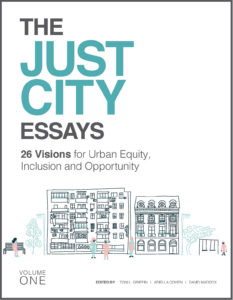“Five years ago, the Harvard Graduate School of Design’s Just City Lab published The Just City Essays: 26 Visions of Inclusion, Equity and Opportunity. The questions it posed were deceptively simple: What would a just city look like? And what could be the strategies to get there? These questions were posed to mayors, architects, artists, philanthropists, educators and journalists in 22 cities, who told stories of global injustice and their dreams for reparative and restorative justice in the city.
 These essays were meant as a provocation, a call to action. Now, during these times of dissonance, unrest, and uncertainty, their contents have become ever more important. For the next 26 weeks [starting June 15, 2020], the GSD and the Just City Lab will republish one essay a week here and at designforthejustcity.org. We hope they may continue conversations of our shared responsibility for the just city.
These essays were meant as a provocation, a call to action. Now, during these times of dissonance, unrest, and uncertainty, their contents have become ever more important. For the next 26 weeks [starting June 15, 2020], the GSD and the Just City Lab will republish one essay a week here and at designforthejustcity.org. We hope they may continue conversations of our shared responsibility for the just city.
We believe design can repair injustice. We believe design must restore justice, especially that produced by its own hand. We believe in justice for Black Americans. We believe in justice for all marginalized people. We believe in a Just City.”
—Toni L. Griffin, Professor in Practice of Urban Planning, founder of the Just City Lab, and editor of The Just City Essays
Right to the City for All: A Manifesto for Social Justice in an Urban Century
By Lorena Zárate
[The Right to the City is] the right to change ourselves, by changing the city.—David Harvey, 2008
The Cities We Have
The cities we have in the world today are far from being places of justice. Whether in the South, the North, the West or the East, the cities we are living in are a clear expression of the increasing inequalities and violence from which our societies suffer, as a direct result of putting capital gains and economic calculations—greed!— before people and nature´s well-being, dignity, needs and rights.
The concentration of economic and political power is a phenomenon of exploitation, dispossession, exclusion and discrimination whose spatial dimensions are clearly visible: dual cities of luxury and misery; gentrification processes that displace and evict traditional and low-income populations; millions of empty buildings and millions of people without a decent place to live; campesinos without land and land without campesinos, subjected to abuses by agro-businesses, mining and other extractive industries and large scale projects.
In other words, injustice emerges from destruction of public and community´s goods and assets, and the weakening of regulation, redistribution and welfare policies in States that instead facilitate private appropriation and accumulation of the commons, the resources and the collectively-created wealth. Continue reading on designforthejustcity.org…
